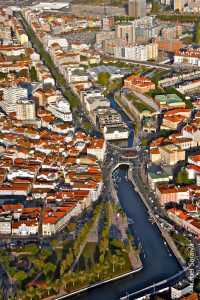Since the late Prehistoric age, there has been human presence in Aveiro, proven by the existence of dolmens in the area. However, the area’s biggest developments occurred in the historic period.
Aveiro has been always connected with commercial activities, namely the production of salt and naval trade.
Salt, a valuable trading good probably used as far back as the Roman era, is documented in this area as far as 959, appearing in Condessa Mumadona Dias’ will, held in Cenóbio monastery in Guimarães.
In the early 15th century, the building of walls around the urban centre reflects the prestige and growth that Aveiro had achieved by that time. Later, religious and charitable institutions would establish themselves in the area, which would for many centuries contribute towards the promotion of the city and help it overcome more difficult times, especially during the 17th and 18th centuries, when the harbour was silted up. The reopening of the harbour, in 1808, would slowly bring activity back to Aveiro, heralding a new age for the area.
The predominance of buildings from the 19th and 20th centuries reflects that prosperous period, also revealing the desire to move with the time’s taste and fashion, evident in the numerous Art Nova features in the city. These features, such as Art Déco or Modernism architecture can also be seen thoroughout the Aveiro area, encouraged by the dictatorial regime of the Estado Novo. Today, perhaps the most interesting modern architecture is that of the University campus, which showcases designs by celebrated national architects.
Alongside progression, tradition remains visible in ethnic elements, such as the architecture of the rural areas of the region, where several aspects of the traditional Portuguese house building style come together. A good example is the “casa gandaresa”. In the Alboi, and particularly in the Beira Mar quarter of the city, you can still find ground houses with tile covered façades, living testimonies to the old “marnotos” [saltpan workers] and fishermen, devoted to St. Gonçalinho and St. Roque.
 The Ria’s estuary, its tributaries and all the beauty of its landscape, dotted with tiny islands are bubbling with biodiversity.
The Ria’s estuary, its tributaries and all the beauty of its landscape, dotted with tiny islands are bubbling with biodiversity.
Further along the estuary, towards the ocean, we find the dunes of St. Jacinto and its nature reserve, a sanctuary for flora and fauna, and the small village with traditions such as lagoon fishing, trawling and fishing for cod in the cold seas off Newfoundland.
The predominance of the ceramic industry in the area is not just a reflection of technological advancement, but rather the result of a long and productive tradition encouraged by the geological constitution of the area, one that goes back at least to the Late Roman/Medieval period, as is evident in the ceramic furnaces of Eixo.
The city of Aveiro, the capital of the district, is one of the main cities in the Central Area of the country (population: 55, 291 approx.) and belongs to the subarea of Baixo Vouga.
It is located about 58 km North of Coimbra and about 68 km South of Porto, and is also the main city in the subarea of Baixo Vouga, the most populated subarea in the Central Area of the country (population 398, 467 approx.). It is also the second most populated city in the Central Area of Portugal, after Coimbra.
Today, this area is experiencing strong economic development, combining traditions from the past with modern day activities. With the help of the university, Aveiro is now reaching a pattern of sustainable development which can guarantee its future.